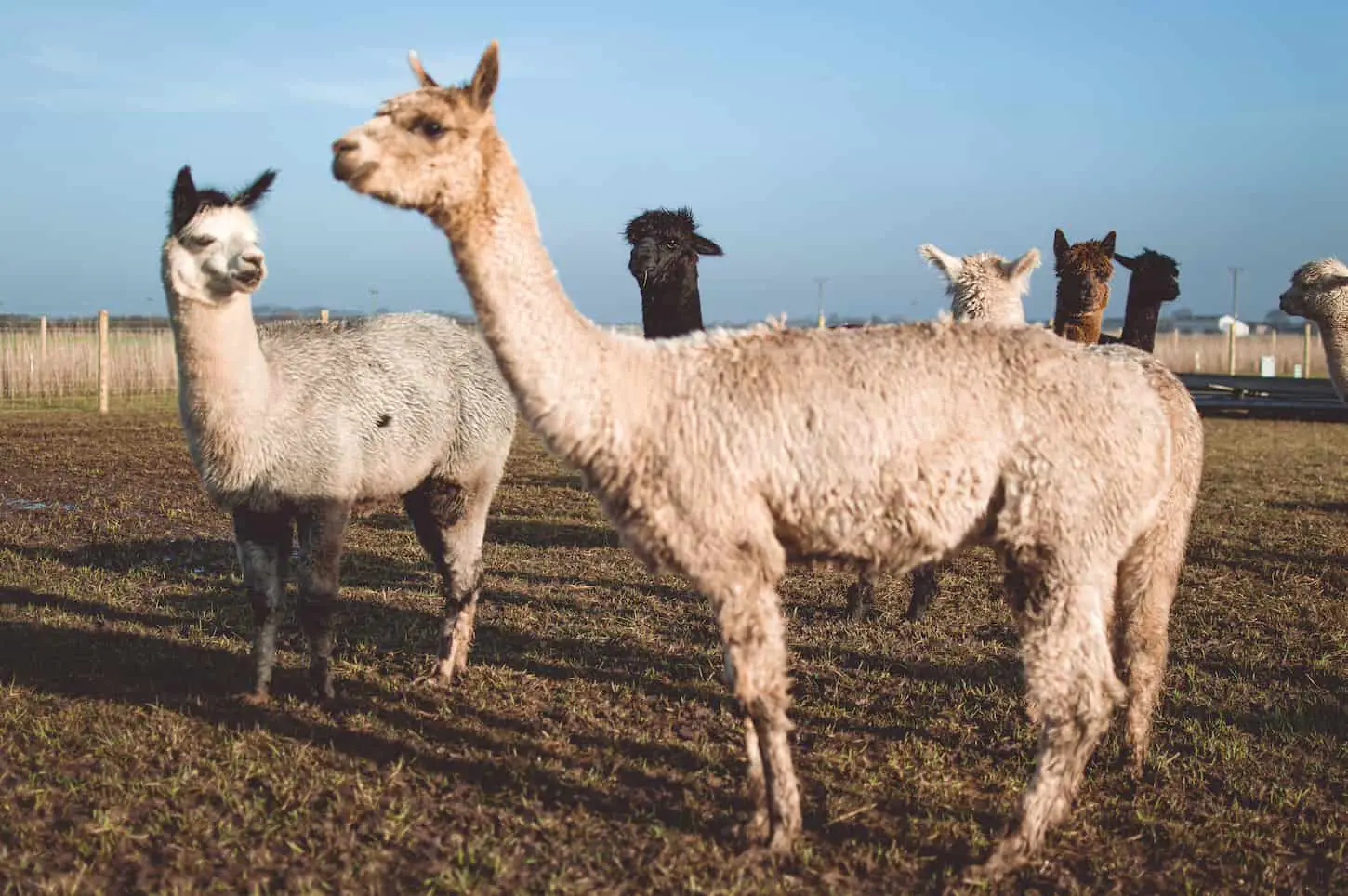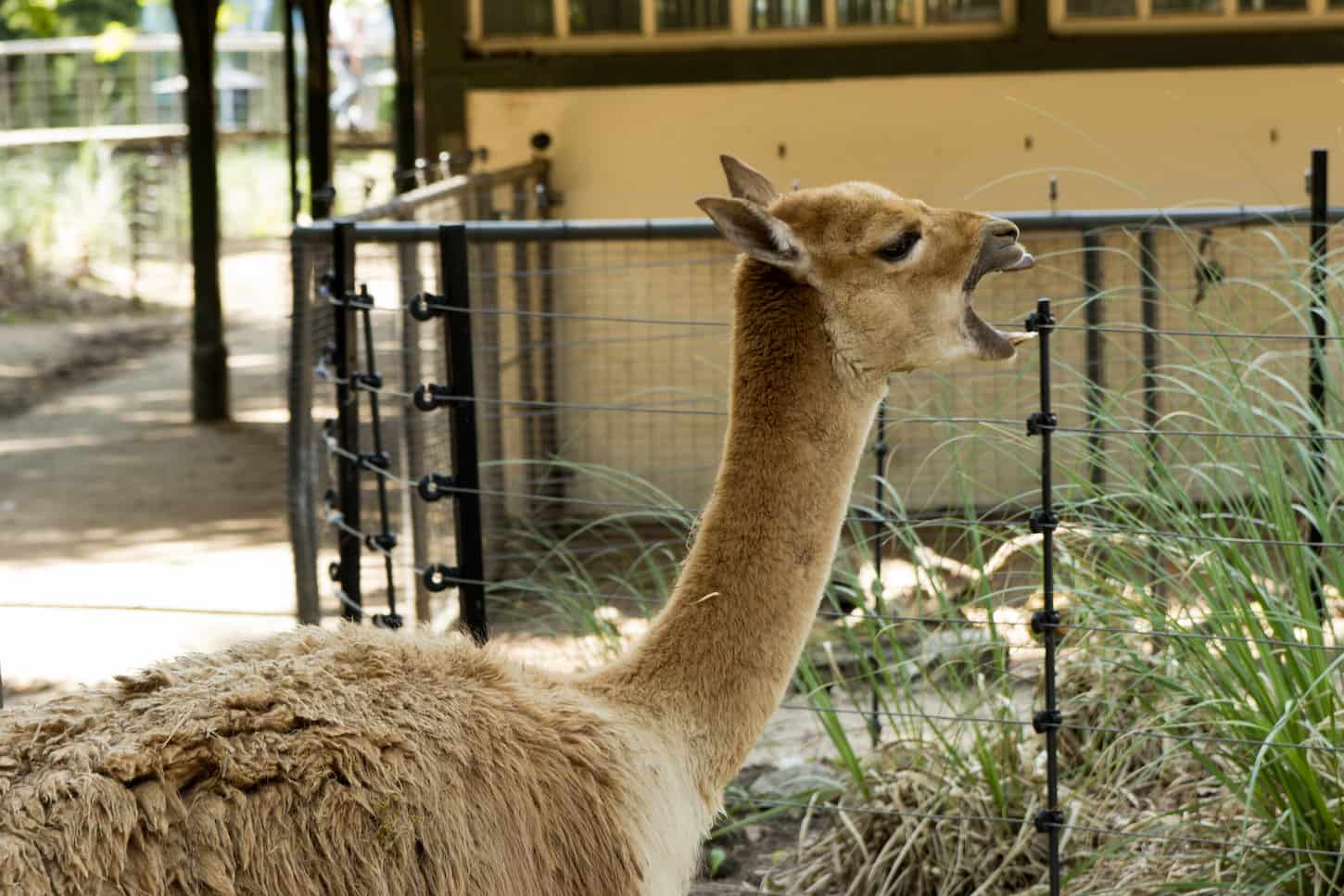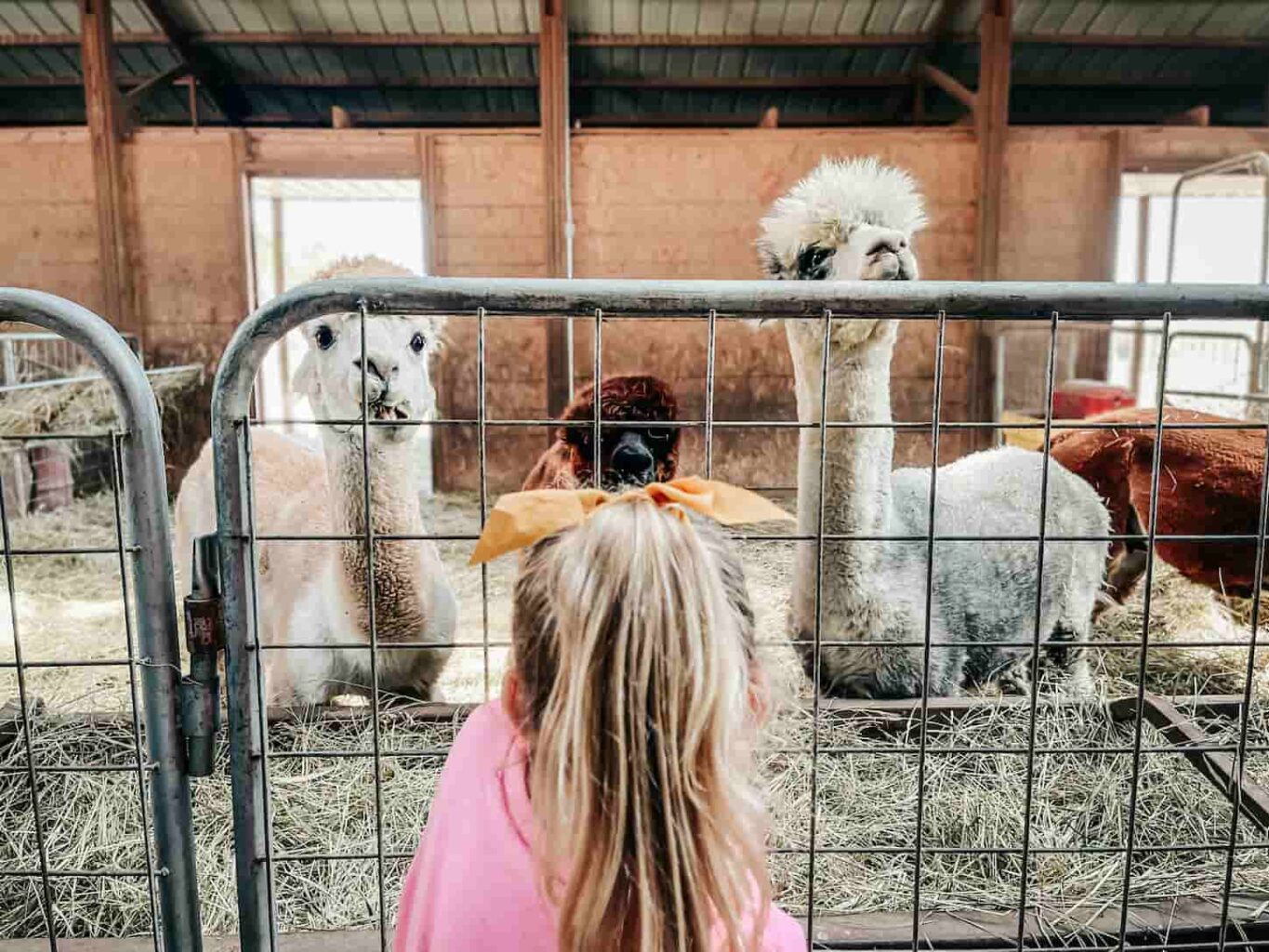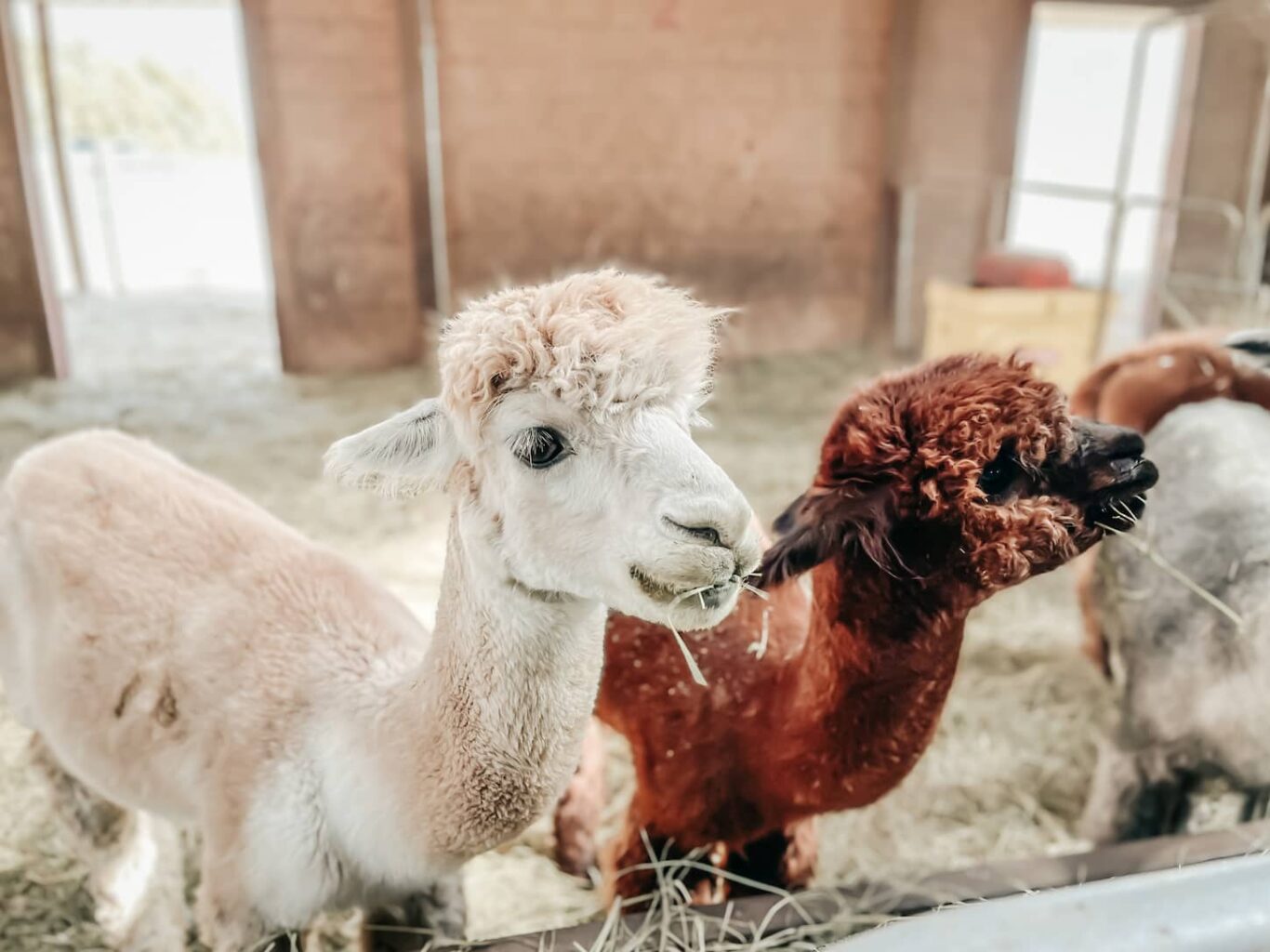Llamas were domesticated around 4,500 BC, and since then, humans have had plenty of time to observe and record all their adorable and often quirky behavior. The sounds they make depend on the social context and environment, which are far from fixed, even for domesticated llamas. Here’s a shortlist of all the other sounds you can expect out of them.
- Llamas’s most versatile sound is the hum that can express many emotions.
- Llamas spit when annoyed or fighting for dominance.
- Llamas produce a clucking sound that serves as a greeting.
- Llamas make an “orgle” sound when they are mating.
- Llamas scream when they get really emotional.
- Llamas groan when they feel pain.
When terrified, llamas produce an alarm call that sounds like a horse singing on a broken trumpet. It’s unique but so is every other charming sound they make. Curious for more information and examples so you can imagine all the sounds? Keep reading below.

What Does a Llama Sound Like?
Llamas are usually quiet, limiting their vocalizations to humming to match the situation unless it is the mating season or if they are scared or alerting the herd of danger when they will scream, spit, and/or cluck. Llamas will also groan or scream if in pain.
Llamas often carry a smug expression, and that’s more than justified. They are very intelligent, as seen by how well they respond to proper training and their ability to read other llamas and animals’ body language to protect themselves and their herd.
Llamas are usually very friendly and peaceful, but the sounds they make can turn very loud when they are fighting or in danger. Let’s not forget that each llama has its personality and distinct traits. All of that means you are bound to hear all sorts of sweet and strange sounds from them depending on what they are up to.

Sound #1: Llamas hum to express many emotions
Llamas hum to express contentedness, boredom, anxiety, greeting others, and even happiness. Each hum has a different pitch and tone depending on the attached emotion and situation. Over time, these meanings can be learned by human caretakers.
The hum is similar to the sound of a purring cat but often comes with a very different emotion attached to it. When llamas hum, it’s usually associated with raised stress and anxiety levels. For example, due to the behavior of other animals in the herd or due to unpleasant temperatures that make them feel uncomfortable.
The reason for humming isn’t always serious. Sometimes llamas hum when they are bored or exhausted. Humming can be heard when they are concerned for somebody or even as a sign of happiness. The sound is also used as a greeting, especially by females who hum to get their babies’ attention.
Еven though this universal sound can often be ambiguous, people who have close relationships with llamas can make pretty accurate guesses about what they mean. This is because the hum differs in tone and pitch, and you can see which variation is produced in which circumstances.
This way, with more experience and time spent together, your predictions grow more accurate. That’s the closest trainers get to telepathy with their soft, llama friends!
Sound #2: Llamas spit when annoyed or fighting for dominance
Llamas come from the same biological family as alpacas and camels. One feature that unites them is their habit of sticking their tongue out and spitting when they are annoyed or displeased by the behavior of another llama.
For example, female llamas will spit at a male to drive him away when she is just not interested.
The spitting sound is often used as a threat by spitting dry air and producing a “pfft” sound. The sound has multiple levels depending on how far back into one of its three stomachs the llama decides to draw the materials from. The more serious the threat, the more vile the spit is and the groaning sounds that are produced.
Victims of spitting can also be humans because the frustration of llamas knows no boundaries. This is a rare situation but can happen when llamas feel threatened and mistreated or when they were not adequately trained and did not develop the necessary behavior habits at a young enough age.
Spitting sounds are often used as a threat to other llamas when herd members are fighting for dominance. Llamas are very social animals, and their rank in the herd can always change, so they must maintain it by standing their ground. Llamas often pick small fights over food and territory or spit at other members of a lower rank as a way to discipline them.
Sound #3: Llamas produce a clucking sound that serves as a greeting
This is a clicking sound that llamas produce for positive and negative situations. Often it’s done as a greeting or when llamas are feeling friendly and content. Sometimes it can be used as a warning to move away when a llama feels threatened by somebody’s presence.
We are not so different from llamas; you can also produce the sound by clicking your tongue against the roof of your mouth while your lips are sealed shut. Congratulations, you are one step closer to sounding like a llama!

Sound #4: Llamas “orgle” when they are mating
The “orgle” is produced by male llamas when they get aroused to attract the llama and continue for the whole mating process. Once it begins, you can expect to continue hearing it for the next 20 to 50 minutes because the mating act for llamas lasts an unusually long time.
People say that some experiences can not be captured in words, and this sound is proof of that. It’s a high-pitched groan that feels loud and assertive, and it sounds somewhere between gargling a liquid in your mouth and choking on your spit. It’s not clear whether the sexual act that can last almost an hour or the ability of a male llama to maintain this sound for that long is a bigger miracle of nature.
If the sound isn’t bizarre enough, how it affects other llamas may be even more strange. If one male begins orgling, then others are likely to start as well because it sends a signal that it may be mating time. This would make the orgle a love song that one male llama begins and the rest start singing along.
Sound #5: Llamas can scream when they get emotional
Llamas constantly fight for social dominance in the herd, and their fights can include more than spitting and ramming into one another. Sometimes llamas who feel especially dramatic will scream at one another.
Llamas can also scream their lungs out when they feel personally in danger and are terrified. The threat doesn’t have to be real. Llamas usually scream when they are restrained for veterinary visits. Sometimes a llama can even cry if a stranger is just gently stroking it.
More often, a scream coming from a llama is an alarm call for others. It’s a high-pitched “mwa” sound that feels as though the llama is making a poor impression of the donkey’s “hee-haw” sound. It’s deafening and piercing so that the other llamas can be quickly warned about the potential danger.
Here is a YouTube video of a llama producing its famous alarm call at around 20 seconds into the video in case you are curious!
A llama may become alarmed by the sight or smell of a predator or even their own shadow if they are nervous! No matter if the threat is real or not, the strength of this shriek means everybody that’s around will hear it.
Sound #6: Llamas groan when they feel pain
A rough groan or a more soft whimper that continues for an extended time can signify that a llama is not just moody. In such cases, it’s best to play it safe and contact a veterinary medical professional to ensure everything is well.
Llamas are very resistant to diseases such as foot & mouth diseases, especially compared to other livestock. They may come from South America, but they don’t usually struggle with adaption to different climates.
Even though they are suited to unfriendly environments, llamas can still get sick. For example, they can suffer infections from intestinal and external parasites or wound themselves somewhere.
How Do You Spell the Sound a Llama Makes?
Each different llama sound may be spelled differently, depending on if it is a scream, an orgle, or spitting. The spelling for spitting is often spelled “pfft,” though it may be spelled differently in English than in Spanish or other languages.
Orgling, for example, sounds a lot like a horse playing the bugle. I don’t know how to spell that sound.

Next Steps
Llamas are cool, and they make some awesome noises. Even so, their camelid cousins, the alpacas, are also cool. Ever wonder what an alpaca sounds like?
While they sound a lot like their llama cousins, there are a few subtle differences in the sounds they make, and a few differences in the meanings.
Go read that article we wrote next: Alpaca Sounds 101: 9 sounds & their meanings. I’m sure you’ll enjoy it!
Resources
Learning from your own experience is essential, but learning from others is also intelligent. These are the sources used in this article and our research to be more informed as homesteaders.
- Twincreek’s Llamas, Frequently Asked Questions, http://www.twincreeksllamas.com/faq/FAQs.htm
- “Alpaca/ Llama Round Robin Questions”, https://s3.wp.wsu.edu/uploads/sites/2054/2014/04/Round-Robin-Studyguide-Alpaca.pdf
- Mystic Water Llamas & Fiber Mill, FAQ’s about Llamas, http://www.mysticwaterllamas.com/id1.html.
- Dartmoor Llama Walks, “Interesting Facts About Llamas”, https://www.dartmoorllamawalks.co.uk/facts-about-llamas/.
- Oregon State University, “Five Cool Things About Llamas”, https://blogs.oregonstate.edu/animalconnection/2012/01/19/five-cool-things-about-llamas/.